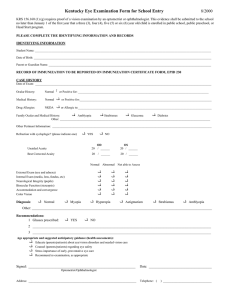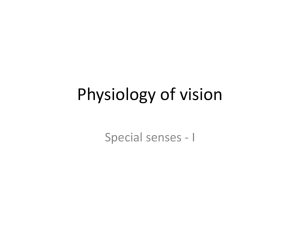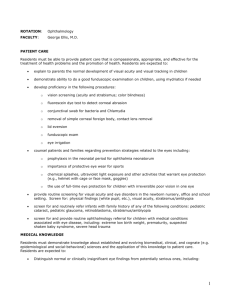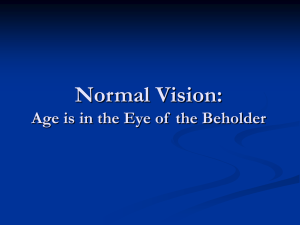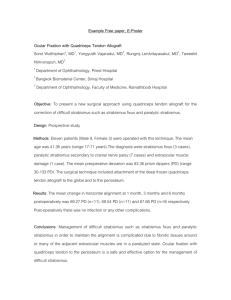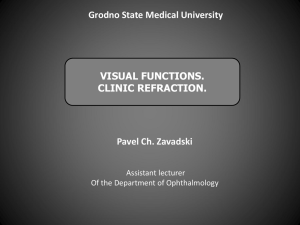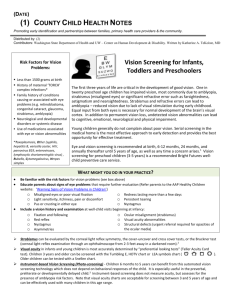Vision Presentation
advertisement
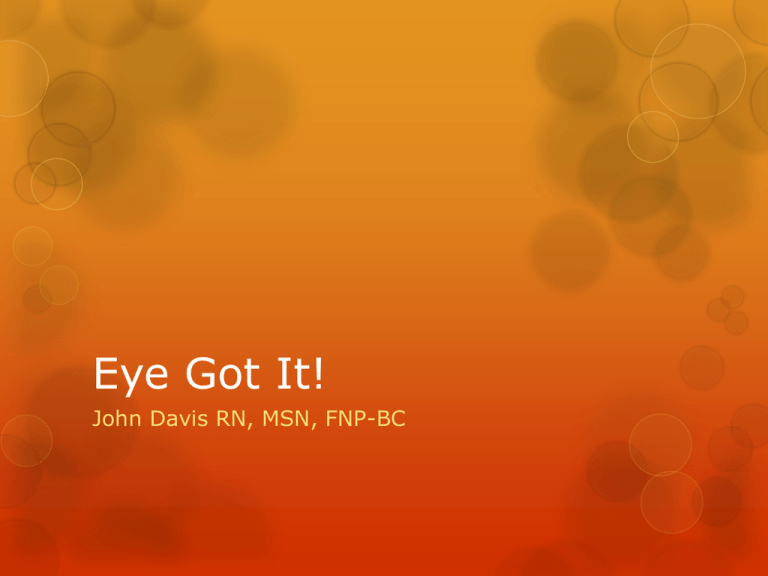
Eye Got It! John Davis RN, MSN, FNP-BC ALL people by nature desire to know. An indication of this is the delight we take in our senses; for even apart from their usefulness they are loved for themselves; and above all others the sense of sight. Aristotle, first line of “Metaphysics” Anatomy Fundoscopy Vocabulary Strabismus- (cross eye) when both eyes don’t look at the same place at the same time. Amblyopia- (lazy eye) is the loss or lack of development of central vision in one eye Esotropia- Form of strabismus in which the eye turns inward. Exotropia-Form of strabismus in which the eye turns outward. Anisocoria- unequal pupil size Dyscoria- irregular pupil shape Leukocoria- white pupil Proptosis- Bulging of the eye anteriorly out of the orbit Diplopia- double vision Ptosis- Drooping of the upper eyelid Myopia- near-sightedness (objects that are near are clear, objects far away appear blurred) Hyperopia- far-sightedness (objects that are far are clear, objects that are close are blurry) Normal Developmental Timeline of Vision Visual Acuity at birth is 20/800 to 20/1000 Visual Acuity at age 6 months is 20/40 to 20/80 Age 6 months to 3 years the child should be able to fixate and follow a face, a toy or a light. Visual Acuity at age 3 to 5 years is 20/40 or better No more than 1 line acuity difference between eyes Visual Acuity at age 6 and older should be better than 20/40 Refer for visual acuity 20/40 and above Should not have any acuity difference between eyes. Visual acuity less than 20/40 is needed for admission to military, law enforcement, aviation industry, and commercial truck driving. Myopia affects about 30% of the U.S. population How to Assess the Eye Check Visual Acuity Use a pinhole if student forgot glasses/contact lenses Check Pupil Size- are they equal, anisocoria? Check Tracking and Convergence Inspect the lids Inspect the conjunctivae- bulbar vs. palpebral Cover Test- To assess for Strabismus / Amblyopia With Lights Turned Down Check Pupil Response- Reactive to light? Afferent Pupillary Defect- Optic Nerve or Retinal disorder Hirschberg Test Red Reflex Tracking Ocular Tracking is the name given to the ability of the eyes to move smoothly, together, to follow an object moving horizontally and vertically. Important to assess after an eye injury for signs of extraocular movement entrapment. In education, tracking refers to eye movement along a fixed target, as in reading. In the past, some children with central processing dysfunctions (learning disabilities) were suspected of difficulty with tracking as a result of, or associated with, a learning disability. There is no scientific evidence to support this notion. Most educators no longer ascribe to this view. Convergence A normal response is a movement of both eyes nasally, with convergence of the two axes of the eyes. An inability of the eyes to converge may be related to: Problem with extraocular muscles Neurological disorder If abnormal- refer immediately to ophthalmology Strabismus Perform the cover-uncover test with children age three years and older. Can be treated and corrected if detected within the first 10 years of life. Treatment is attempted for older children as well but not always correctible. Occurs in 5-7% of children. May have persistent squinting, head tilting, face turning, awkwardness, or decreased visual acuity in one eye. Treatment: Correct refractive error if present. Eye patching- good eye Atropine drops Surgical correction Strabismus Strabismus Refer immediately if new onset strabismus develops in a school age child. Need to rule out tumor: Glioma Astrocytoma Neuroblastoma Medulloblastoma Viral Conjunctivitis Most commonly adenovirus. Adenovirus does not have a lipid coat. Usually watery discharge, occasionally purulent. Tender swollen preauricular lymph node. Contagious for 7-10 days. Treat with artificial tears, frequent hand washing. Bacterial Conjunctivitis Usually caused by Staph aureus, Strep pneumo, or H. influenzae. 70% of staph resistant to erythromycin Can treat with bacitracin, avoid neomycin (neosporin) Purulent discharge Eyes crusted shut Can return to school after 24 hours of antibiotic treatment. Allergic Conjunctivitis Almost always involves both eyes. Eyes are red and itchy No preauricular lymph node swelling or tenderness Allergic Shiners Clear drainage or stringy mozzarella cheese looking drainage Not contagious but uncomfortable Ophthalmic anti-histamines and opthalmic mast cell stabilizers to treat Subconjunctival Hemorrhage Does it affect vision? Is it painful? If no- you have your diagnosis. Broken blood vessel under the surface of the eye. Can be caused by a strong sneeze or cough. Harmless Resolves in 10-14 days. Orbital Cellulitis Orbital Cellulitis Ocular emergency No history of injury Eye is red, warm to touch, swollen, painful Orbit has a direct line to the central nervous system via the optic nerve- child needs to be hospitalized for IV antibiotics. Orbital Wall Fracture Ocular emergency Check the extraocular movments of the eye. If eye is trapped, consider orbital wall fracture and seek emergency care. Assess vision- if decreased or vision loss seek emergency care. If proptosis present or open/perforated globe suspected- shield the eye and seek immediate emergency care. Retinoblastoma Cancer of the retina Typically develops before age 5 Leukocoria- white pupil Absent red reflex Particularly noticeable in photographs taken with a flash Autosomal dominant- often family history of retinoblastoma Curable when diagnosed early Which part of the body has the thinnest layer of skin? Hordeolum (Stye) Hordeolum (Stye) Localized inflammatory swelling of one or more of the glands of the eyelid Mildly tender May discharge purulent fluid Exclude from school if draining until on antibiotics. Treatment: Warm compresses Massage Topical antibiotics if pointing outward Occasionally incision and drainage Chalazion Chalazion Chronic version of stye. Meibomian gland is the main sebaceous gland of the eye. If the meibomian gland becomes plugged or constipated- chalazion forms. Treatment: Warm Compresses Massage Oral antibiotics if infection is present as topical will not infiltrate the area. If above treatment is not effective, surgical excision is necessary. Cornea The cornea is a smooth, transparent, avascular structure that covers the iris and joins with the sclera and conjunctival reflection at the limbus. The cornea functions as a protective window, allowing light to pass in to the eye. The cornea is richly innervated by the trigeminal, or fifth cranial, nerve and is therefore exquisitely sensitive to touch. Corneal Ulcer White or gray spot on the cornea Very painful Refer immediately Causes: Contact Lense Wearers Bacterial infection Herpes simplex or zoster infection Corneal abrasion (scratch on the eye) if it becomes infected Chemical burn Mydriasis Thank you!

